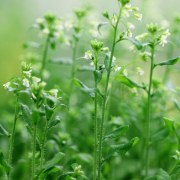Nature: FLM splice form antagonism in flowering
How two splice forms of the FLM transcription factor antagonize each other to control temperature dependent flowering
Markus Schmid’s group, with help from Detlef Weigel’s PhD student Felix Ott (who was responsible for the bioinformatic analyses), in collaboration with Richard Immink and Gerco Angenent from Wageningen, show how two splice forms of the FLM transcription factor antagonize each other to control temperature dependent flowering.
Temperature-dependent regulation of flowering by antagonistic FLM variants
David Posé, Leonie Verhage, Felix Ott, Levi Yant, Johannes Mathieu, Gerco C. Angenent, Richard G. H. Immink & Markus Schmid
Nature (2013) doi:10.1038/nature12633
The appropriate timing of flowering is crucial for plant reproductive success. It is therefore not surprising that intricate genetic networks have evolved to perceive and integrate both endogenous and environmental signals, such as carbohydrate and hormonal status, photoperiod and temperature1, 2. In contrast to our detailed understanding of the vernalization pathway, little is known about how flowering time is controlled in response to changes in the ambient growth temperature. In Arabidopsis thaliana, the MADS-box transcription factor genes FLOWERING LOCUS M (FLM) and SHORT VEGETATIVE PHASE (SVP) have key roles in this process3, 4. FLM is subject to temperature-dependent alternative splicing3. Here we report that the two main FLM protein splice variants, FLM-? and FLM-?, compete for interaction with the floral repressor SVP. The SVP–FLM-? complex is predominately formed at low temperatures and prevents precocious flowering. By contrast, the competing SVP–FLM-? complex is impaired in DNA binding and acts as a dominant-negative activator of flowering at higher temperatures. Our results show a new mechanism that controls the timing of the floral transition in response to changes in ambient temperature. A better understanding of how temperature controls the molecular mechanisms of flowering will be important to cope with current changes in global climate5, 6.



